 W
WThe Annunciation is a painting by the Italian Renaissance master Titian, executed between 1559 and 1564. It remains in the church of San Salvador in Venice, for which it was commissioned.
 W
WAscent of the Blessed is a Hieronymus Bosch painting made between 1505 and 1515.
 W
WThe Assumption of the Virgin or Frari Assumption is a large altarpiece panel painting in oils by the Italian Renaissance artist Titian, painted in 1515–1518. It remains in the position it was designed for, on the high altar of the Basilica di Santa Maria Gloriosa dei Frari or Frari church in Venice. It is the largest altarpiece in the city, with the figures well over life-size, necessitated by the large church, with a considerable distance between the altar and the congregation. Please note the images above and below are not Titian's work, they are by Palma Vecchio. It marked a new direction in Titian's style, that reflected his awareness of the developments in High Renaissance painting further south, in Florence and Rome, by artists including Raphael and Michelangelo. The agitated figures of the Apostles marked a break with the usual meditative stillness of saints in Venetian painting, in the tradition of Giovanni Bellini and others.
 W
WBaptism of Christ is a painting by Italian Renaissance painter Cima da Conegliano, dating from 1492. It is housed in the church of San Giovanni in Bragora in Venice.
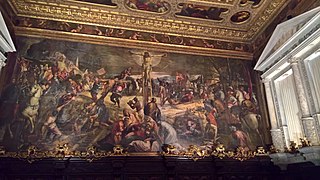 W
WThe Crucifixion by Tintoretto is a large painting in oil on canvas, installed in the Sala dell'Albergo of the Scuola Grande di San Rocco, Venice. It is signed and dated 1565. This painting is of the most dramatic versions of the Crucifixion in the history of Christian religious art.
 W
WThe Crucifixion of St Julia is a triptych by the Dutch painter Hieronymus Bosch. Like many Bosch paintings, the date of this work was long disputed, until dendochronologic analysis assigned it to around 1497. It is housed at the Palazzo Ducale in Venice.
 W
WFall of the Damned into Hell is a Hieronymus Bosch painting made sometime before 1490. It is currently in the Palazzo Ducale, in Venice, Italy.
 W
WHell is a Hieronymus Bosch painting made after 1490. It is currently in the Palazzo Ducale, in Venice, Italy.
 W
WThe Hermit Saints is a religious oil on panel painting displayed as a triptych, meaning it is one whole painting composed of three separate scenes. This artwork was made by the Renaissance artist Hieronymus Bosch, dating from 1493. The entirety of the triptych painting measures 86 x 60 cm. This artwork is currently being housed at the Gallerie dell'Accademia, Venice.
 W
WThe Last Supper is a painting by the Italian Renaissance artist Jacopo Tintoretto. An oil painting on canvas executed in 1592–1594, it is housed in the Basilica di San Giorgio Maggiore in Venice, Italy.
 W
WLittle Machine Constructed by Minimax Dadamax in Person (1919–20) is a mixed-media work of art by the German dadaist and surrealist Max Ernst.
 W
WMadonna and Child with St John the Baptist and St Catherine of Alexandria or Mystic Marriage of Saint Catherine with St John the Baptist is a c.1504 oil on panel painting by Andrea Previtali, produced during his youthful years in Giovanni Bellini's studio. Belonging to the sacra conversazione genre, it is now in the sacristy of the church of San Giobbe in Venice, whilst a autograph copy of the work is now in the National Gallery, London. The London work includes a scroll below Mary inscribed + 1504/Andrea Cordelle/Agi dissipulus/iouanis Bellini/pinxit and the number 24, variously interpreted as the artist's age or as his personal symbol using the signus tabellanolis, a technique used by 16th century notaries the better to identify works' and documents' authenticity.
 W
WThe Martyrdom of Saint Bartholomew is a 1722 oil on canvas painting by Giambattista Tiepolo, produced during the first years he was active in Venice. It still hangs in the church of San Stae in the city, for which it was painted.
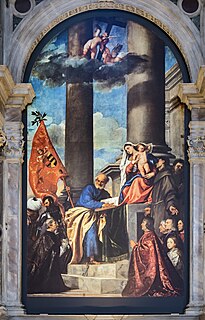 W
WThe Pesaro Madonna is a painting by the late Italian Renaissance master Titian, commissioned by Jacopo Pesaro, whose family acquired in 1518 the chapel in the Frari Basilica in Venice for which the work was painted, and where it remains today. Jacopo was Bishop of Paphos, in Cyprus, and had been named commander of the papal fleet by the Borgia pope, Alexander VI. This painting recalls one of Titian's earliest paintings Jacopo Pesaro being presented by Pope Alexander VI to Saint Peter, c. 1510-11
 W
WThe Presentation at the Temple is a painting of the Presentation of Jesus at the Temple by the Italian master Giovanni Bellini, dating to c. 1460. It is housed in the Fondazione Querini Stampalia, in Venice, Italy.
 W
WSaint Nicholas in Glory is an altarpiece painting by Italian Renaissance artist Lorenzo Lotto, executed in 1527-1529 and located in the church of Santa Maria dei Carmini, Venice.
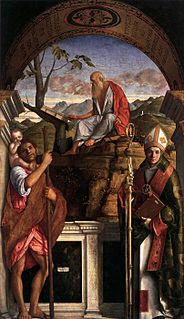 W
WSaints Christopher, Jerome and Louis of Toulouse is a painting by the Italian Renaissance artist Giovanni Bellini, executed in 1513, and housed in the church of San Giovanni Crisostomo, Venice.
 W
WThe San Giacomo dell'Orio Altarpiece (or Madonna and Four Saints) is a painting by the Italian High Renaissance artist Lorenzo Lotto, dating from 1546 and housed in the church of San Giacomo dell'Orio in Venice. It is signed and dated on the cartouche hanging at the throne's base, reading "In tempo de Maistro Defendi de Federigo et compagni 1546 Lor. Lot". The canvas is one of the last works executed by Lotto in Venice, before moving to the Marche.
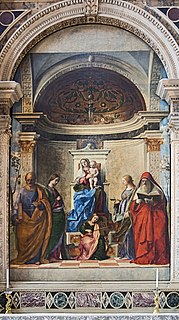 W
WThe San Zaccaria Altarpiece is a painting by the Italian Renaissance painter Giovanni Bellini, executed in 1505 and located in the church of San Zaccaria, Venice.
 W
WSt Antoninus Giving Alms or The Alms of St Antoninus is a c.1540-1542 oil on canvas painting by Lorenzo Lotto. It shows Antoninus of Florence and is now in the basilica dei Santi Giovanni e Paolo in Venice.
 W
WThe St John Chrysostom Altarpiece is a 1510–1511 oil on canvas painting by Sebastiano del Piombo, that is kept in San Giovanni Grisostomo, Venice. It belongs to the sacra conversazione genre.
 W
WSt. Augustine in His Study is a painting by the Italian Renaissance artist Vittore Carpaccio housed in the Scuola di San Giorgio degli Schiavoni of Venice, northern Italy.
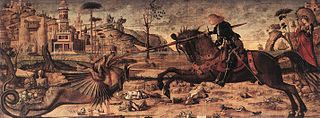 W
WSt. George and the Dragon is a painting by the Italian Renaissance artist Vittore Carpaccio. It is housed in the Scuola di San Giorgio degli Schiavoni of Venice, northern Italy.
 W
WSupper in the House of Simon the Pharisee is a 1544 oil on canvas painting by Moretto da Brescia, now in the Chiesa della Pietà in Venice, Italy.
 W
WTerrestrial Paradise is a painting by Netherlandish artist Hieronymus Bosch, dating from around 1490. It is now in the Palazzo Grimani di Santa Maria Formosa in Venice, Italy. The painting depicts Terrestrial Paradise, where the remaining sins of the saved were washed away. The Fountain of Life stands on top of the hill.
 W
WThe Doge's Palace is a palace built in Venetian Gothic style, and one of the main landmarks of the city of Venice in northern Italy. The palace was the residence of the Doge of Venice, the supreme authority of the former Republic. It was built in 1340, and extended and modified in the following centuries. It became a museum in 1923, and is one of the 11 museums run by the Fondazione Musei Civici di Venezia.
 W
WThe Visitation is a c.1588 oil painting of the Biblical Visitation by Tintoretto, held in the Scuola Grande di San Rocco in Venice. The picture, first recorded in a 1588 receipt, hangs high over an arch on the main staircase,
 W
WWoman at the Café is a 1931 painting by the Italian artist Antonio Donghi. It depicts a lone woman at a café table.